Environmental DX across Entire Supply Chains to Achieve Carbon Neutrality
Highlight
The ongoing global adoption of regulatory frameworks for achieving carbon neutrality in 2050, most notably in Europe, has led to companies in manufacturing and other sectors being called upon to disclose their product GHG emissions. The challenge with this is to find efficient ways of determining these emissions, not just within individual companies, but across the entire supply chain. In response, Hitachi has been aggressively pursuing environmental DX initiatives that encompass entire supply chains.
This article describes use cases that utilize the supply chain platform TWX-21 and the HIPF integrated data platform, presenting these as examples of environmental DX that encompasses entire supply chains. By providing efficient ways to determine product GHG emissions, Hitachi is helping customers overcome the challenges they face.
Introduction
The environment in which companies operate is undergoing rapid changes accompanied by growing stakeholder concerns about sustainability, making it vital that companies address the issues being raised.
A strong emphasis is being placed on environmental action in particular, making this an important facet of sustainable management. Here, corporate action on reducing emissions is being driven by developments such as national commitments to decarbonization and the associated policy reforms, with rising demand for carbon neutrality measures such as tracking greenhouse gas (GHG) emissions and taking action to reduce them ahead of these new regulations coming into force.
Action to comply with regulatory requirements for reporting the carbon footprints of individual products (CFPs) and moves to achieve carbon neutrality through life cycle assessment (LCA) are expected to accelerate around the world, especially in Europe.
It is evident that these developments both at home and overseas make it important for companies to tabulate their CFPs and act on the results. This presents companies with the challenge of finding efficient ways to determine their product GHG emissions, not only internally, but also throughout their entire supply chains.
Use of Environmental DX to Resolve Challenges
Figure 1—Model for Environmental DX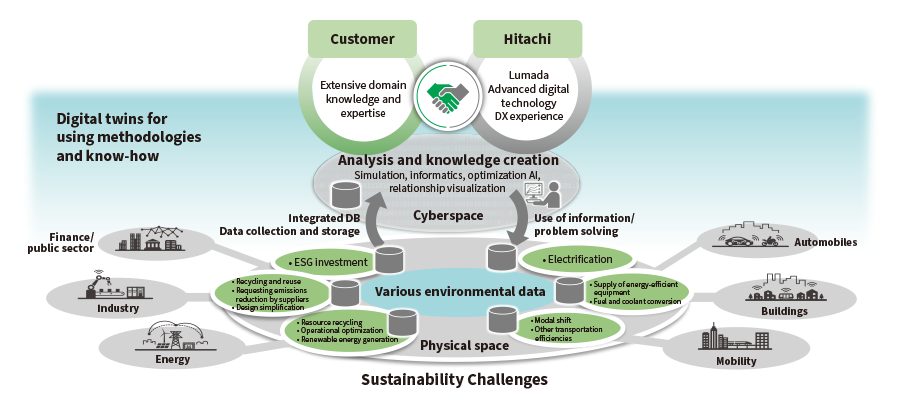 DB: database, DX: digital transformation, AI: artificial intelligenceThe use of cyberspace is seen as critical to success in overcoming the sustainability challenges facing different industries, requiring the collection of large amounts of environmental data and its analysis by digital technology to create knowledge.
DB: database, DX: digital transformation, AI: artificial intelligenceThe use of cyberspace is seen as critical to success in overcoming the sustainability challenges facing different industries, requiring the collection of large amounts of environmental data and its analysis by digital technology to create knowledge.
Figure 1 shows a model of how environmental digital transformation (DX) could be structured to enable action on achieving carbon neutrality. Resolving the sustainability challenges confronting different industries will require the collation of large amounts of environmental data and its analysis by digital technology to create knowledge. Also crucial to the pursuit of DX is that it is undertaken through collaborative creation because it is necessary to draw on the customer’s own domain knowledge and expertise, as well as Hitachi’s digital technologies and experience.
Next, action on carbon neutrality also needs to work through a plan, do, check, act (PDCA) cycle of determining actual GHG emissions [especially carbon dioxide (CO2), which accounts for the bulk of emissions], formulating reduction plans, implementing these actions, and measuring the outcomes.
Information (data) about the environment is vital to this cycle. Rather than simply collecting the sort of data generated by corporate activity, the key question is how to manage the data so that it can be put to efficient and effective use.
To address these issues and requirements, Hitachi has been seeking to add value in ways that fulfill the expectations of the sustainability market, including by working in tandem with its Omika Green Network (OGN)(1) initiative and its EcoAssist(2) series of environmental information solutions to trial the visualization of CO2 emissions and to develop a prototype for dealing with product-specific CO2 emissions. With TWX-21 and Hitachi Intelligent Platform (HIPF)/Environmental DX, it has also developed solutions and platforms for putting data to use in environmental DX across the entire supply chain.
Environmental DX Use Cases and How to Put Them into Practice
Figure 2 shows environmental DX use cases for determining product CO2 emissions using solutions and platforms (TWX-21 and HIPF/Environmental DX) designed to use data for this purpose across entire supply chains. Similarly, Figure 3 shows how these environmental DX use cases are implemented in practice.
As environmental DX is a new activity, there remains considerable scope for finding better ways to make the transition to DX and automation. In addition to tabulating and presenting information on CO2 emissions, implementing these use cases will require efficient data collection and modeling along with the means to put this data to use. Hitachi’s TWX-21 and HIPF combine data platforms that cover entire supply chains with traceability functions for making use of the data. By developing systems that use these in tandem with environmental packages such as the EcoAssist series, which has seen extensive use in tabulation and visualization solutions, Hitachi offers efficient ways to keep track of CO2 emissions throughout the entire supply chain.
In response to the requirement for product CO2 emissions disclosure along with other issues facing their customers and wider society, the practice at many companies has been to collect the required information manually and then to tabulate it in accordance with the rules. By adopting the system configuration shown in Figure 3, however, the solutions and platforms developed by Hitachi for using data for environmental DX are able to provide analysis and traceability in a way that includes the collection and tabulation of the relevant data. The collected data can also be put to other uses, thereby providing the means to resolve management challenges facing customers that extend beyond environmental matters.
Together, TWX-21 and HIPF provide data solutions and platforms for environmental DX. The following section gives an overview.
Figure 2—Environmental DX Use Cases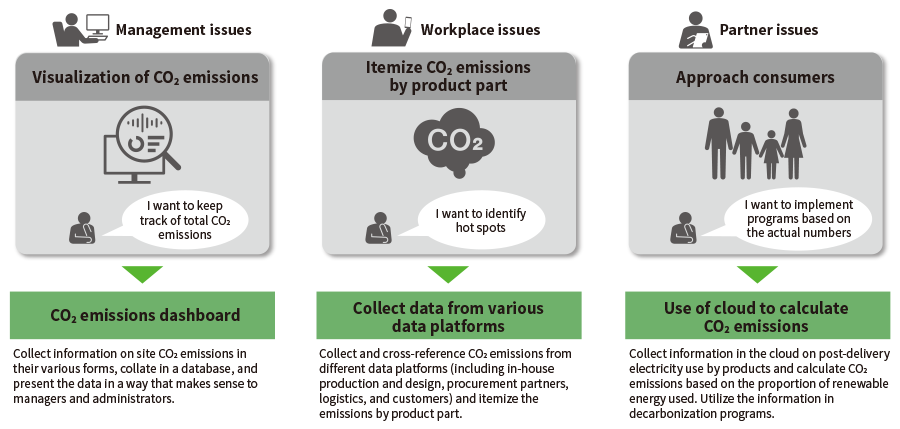 Environmental DX involves building digital twins that incorporate data relevant to environmental applications to determine CO2 emissions across entire supply chains, including emissions by other companies, and the analysis of this data to create knowledge.
Environmental DX involves building digital twins that incorporate data relevant to environmental applications to determine CO2 emissions across entire supply chains, including emissions by other companies, and the analysis of this data to create knowledge.
Figure 3—Data Platform for Environmental DX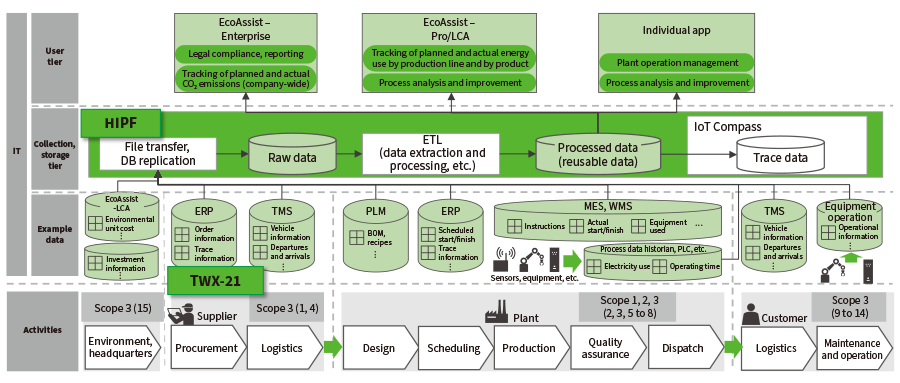 ETL: extract, transform, load, IoT: Internet of Things, LCA: life cycle assessment, ERP: enterprise resources planning, TMS: transport management systems, PLM: product lifecycle management, PLC: programmable logic controller, MES: manufacturing execution system, WMS: warehouse management systemEnvironmental data from within the company is collected on a central platform where it is available for use in carbon neutrality initiatives.
ETL: extract, transform, load, IoT: Internet of Things, LCA: life cycle assessment, ERP: enterprise resources planning, TMS: transport management systems, PLM: product lifecycle management, PLC: programmable logic controller, MES: manufacturing execution system, WMS: warehouse management systemEnvironmental data from within the company is collected on a central platform where it is available for use in carbon neutrality initiatives.
TWX-21 Supply Chain Platform
If companies want to determine the Scope 3 CO2 emissions of goods they purchase from upstream in the supply chain (raw materials, parts, etc.), they need to obtain this information from their suppliers. Unfortunately, suppliers may lack the expertise, wherewithal, or other resources needed to calculate their emissions on a per-product basis.
To overcome this problem, Hitachi intends to offer a new service on TWX-21, its software as a service (SaaS) that supports business-to-business transactions. The service will use electronic data interchange (EDI) data collected by its Web-EDI service for the procurement and purchasing activities of buyers and suppliers to calculate the per-product CO2 emissions of suppliers (Scope 3 upstream emissions) automatically and convey this information to buyers (see Figure 4).
Hitachi is also participating in a demonstration project run by the Green × Digital Consortium(3). The expectation is that providing this per-product CO2 emissions information from TWX-21 to other solutions, whether in-house or at other companies (Scope 1, 2, and 3 downstream emissions), will help with determining CO2 emissions and enable reductions across entire supply chains.
Figure 4—Overview of Service Using TWX-21 for Automatic Calculation of Per-product CO2 Emissions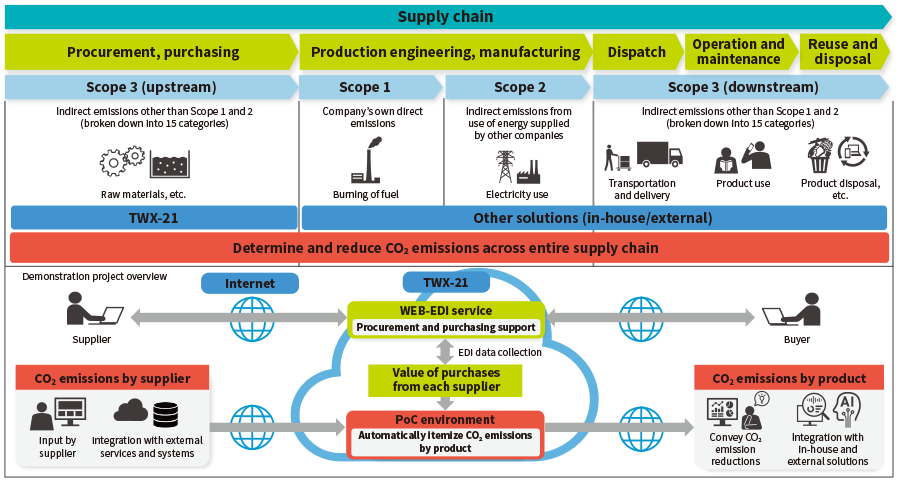 EDI: electronic data interchange, PoC: proof of conceptPer-product CO2 emissions are calculated using per-supplier CO2 emissions input by suppliers or obtained through interoperation with external services or systems and from the value of purchases from each supplier obtained from EDI data. Not only does this eliminate the need for suppliers to calculate the CO2 emissions for everything they supply, but it also informs buyers about CO2 emission reductions by their suppliers.
EDI: electronic data interchange, PoC: proof of conceptPer-product CO2 emissions are calculated using per-supplier CO2 emissions input by suppliers or obtained through interoperation with external services or systems and from the value of purchases from each supplier obtained from EDI data. Not only does this eliminate the need for suppliers to calculate the CO2 emissions for everything they supply, but it also informs buyers about CO2 emission reductions by their suppliers.
HIPF Integrated Data Platform
Figure 5—Overview of Hitachi Intelligent Platform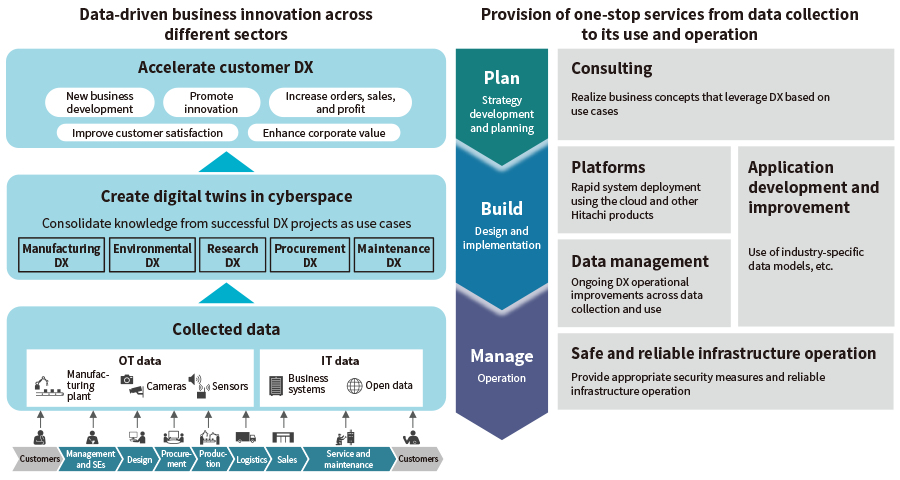 OT: operational technology, SE: system engineerHitachi Intelligent Platform (HIPF) is a new brand for managed data services. It draws on know-how from successful projects at Hitachi and elsewhere to offer a one-stop source of everything from consulting to deployment and operation.
OT: operational technology, SE: system engineerHitachi Intelligent Platform (HIPF) is a new brand for managed data services. It draws on know-how from successful projects at Hitachi and elsewhere to offer a one-stop source of everything from consulting to deployment and operation.
At many manufacturers, calculating CO2 emissions in the supply chain involves the commitment of considerable manpower and time for data collection and tabulation. The tabulation of Scope 3 and per-product CO2 emissions, in particular, takes a lot of time and effort due to data being scattered across different systems.
As a new brand for managed data services, HIPF(4) is an integrated data platform that draws on know-how from successful projects at Hitachi and elsewhere to offer a one-stop source of everything from consulting to deployment and operation (see Figure 5).
In addition to the efficient data collection and modeling for environmental DX described in this article, Hitachi is also looking ahead to resolving the challenges described above by using HIPF as a mechanism for putting data to use. In this role, it can marshal improvements in business value for customers based on knowledge and expertise in the collection, collation, analysis, and use of data obtained from past applications, extending from deciding on how data is to be used to design, development, and operation.
Conclusions
Driven by measures such as the Carbon Boarder Adjustment Mechanism (CBAM) and Ecodesign for Sustainable Products Regulation (ESPR), two European Union (EU) initiatives aimed at achieving carbon neutrality in 2050, environmental DX activities in environmental markets are expected to see the spread of regulation worldwide. Moreover, it is also anticipated that the sustainability sector will see market growth in the lead up to 2050 for environmental DX activities that enable efficient disclosure of product GHG emissions as they become a requirement globally.
Given this anticipated market growth, in addition to its pursuit of carbon neutrality, Hitachi is also seeking to expand its green transformation (GX) businesses, including by considering involvement in resource recycling businesses in the circular economy sector. By consolidating the platforms used for data collection as part of its work on DX, Hitachi also believes that it can make a significant contribution to expanding businesses that utilize data in ways that are suitable for different use cases and challenges. This will enable customers to take on not only environmental DX activities, but also various forms of DX in areas such as production, research, and procurement.
REFERENCES
- 1)
- Hitachi, Ltd., “Omika Green Network”
- 2)
- Hitachi Ltd., “Hitachi Environment Solutions”
- 3)
- Hitachi News Release, “Hitachi Success in Demonstration Project of CO2 Data Coordination in a Virtual Supply Chain by Green × Digital Consortium” (Aug. 2023) in Japanese
- 4)
- Hitachi Ltd., “Hitachi Intelligent Platform Accelerating DX Growth Cycle” in Japanese



